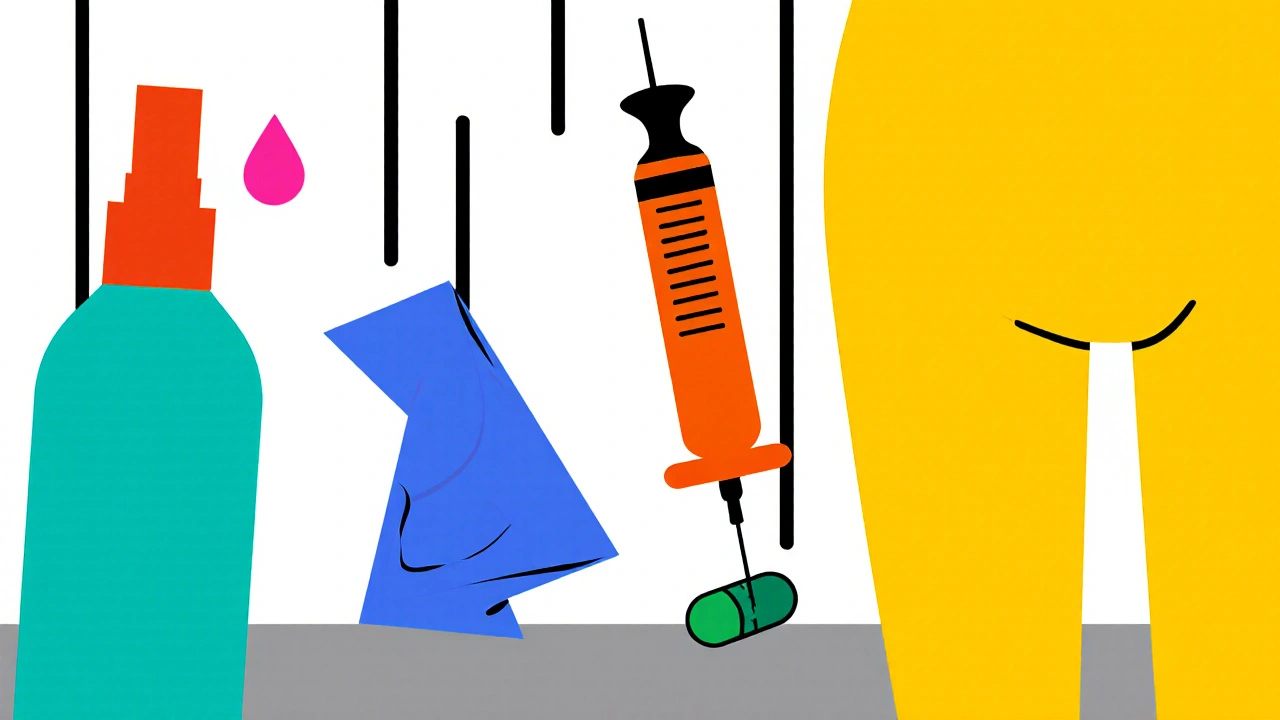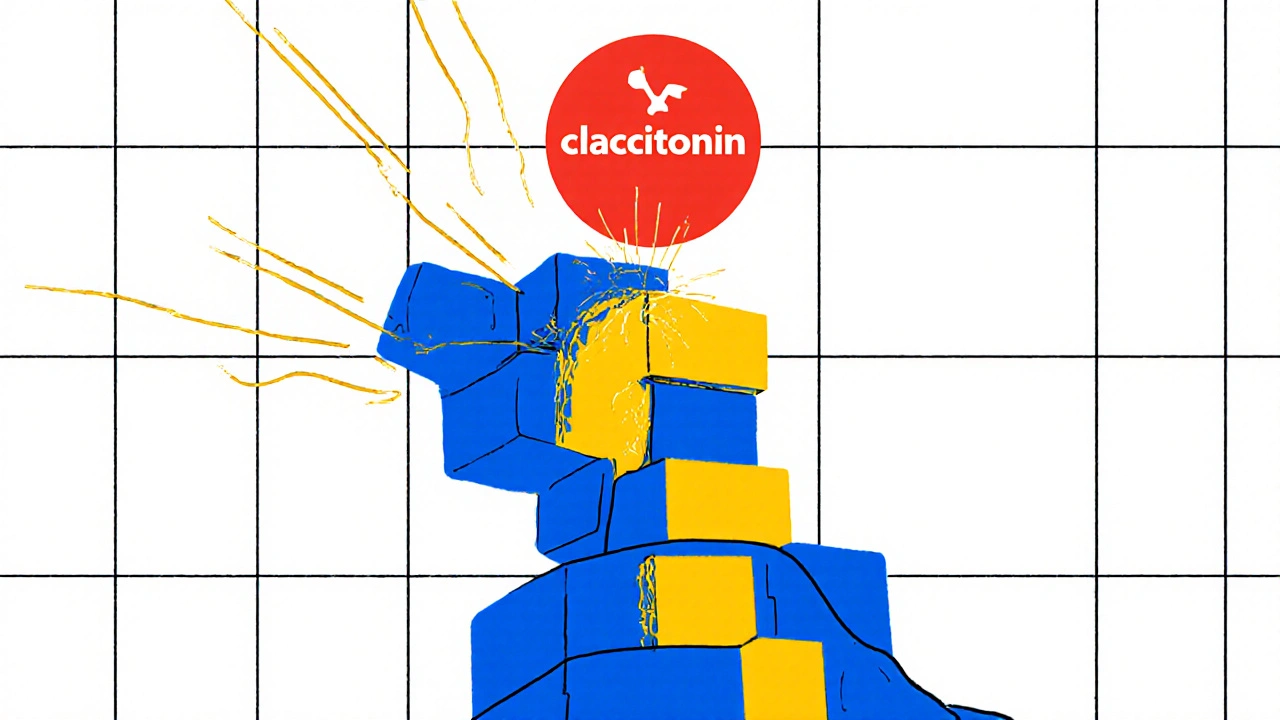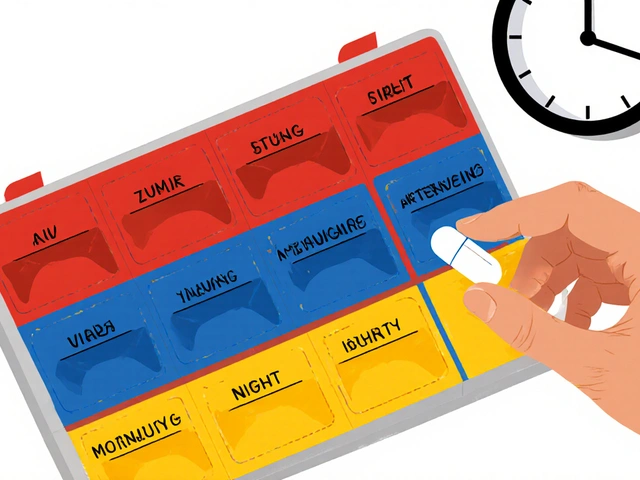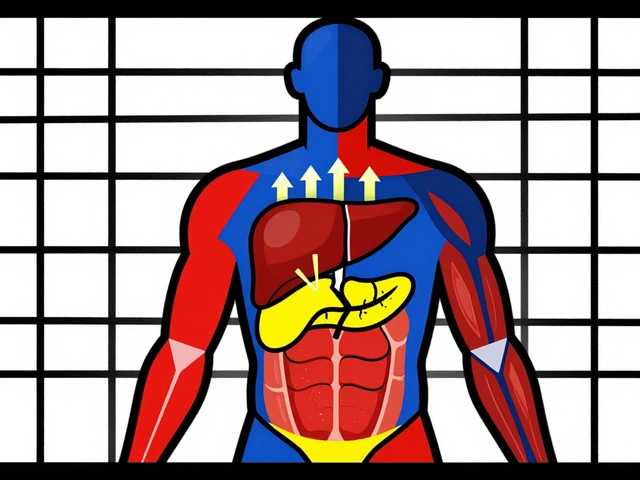Bone Density Improvement Calculator
Compare Bone Density Improvement
Estimate how much your bone mineral density might improve with different osteoporosis treatments over time. Based on clinical data from the article.
Estimated Bone Density Improvement:
Quick Takeaways
- Calcitonin is a hormone‑based medication that slows bone loss in osteopenia.
- It can be given as a nasal spray or a subcutaneous injection, typically once daily or weekly.
- Compared with bisphosphonates, calcitonin has a milder effect on bone density but fewer gastrointestinal issues.
- Common side effects include mild nasal irritation, nausea, and rare allergic reactions.
- Always pair treatment with calcium, vitamin D, and weight‑bearing exercise for best results.
Understanding Osteopenia
Osteopenia is a condition where bone mineral density (BMD) falls below normal ranges but isn’t low enough to be classified as osteoporosis. Think of it as a warning sign: the skeleton is losing density faster than expected, raising the risk of fractures down the line. In 2024, the International Osteoporosis Foundation reported that roughly 43 % of post‑menopausal women and 20 % of men over 50 show osteopenic BMD on a DEXA scan.
Why does this happen? Bone is constantly being rebuilt in a process called remodeling. When the breakdown phase (resorption) outpaces the building phase (formation), density drops. Hormonal shifts-especially reduced estrogen or testosterone-plus inadequate calcium and vitamin D, tip the balance toward loss.
What Is Calcitonin?
Calcitonin is a naturally occurring hormone produced by the thyroid’s C‑cells. Its primary job is to lower blood calcium by inhibiting osteoclasts, the cells that chew away bone. Synthetic versions, first approved by the FDA in the 1970s, mimic that effect and are used when doctors need a quick, short‑term slowdown of bone loss.
Because calcitonin directly curbs resorption, it can raise BMD modestly-usually 1‑2 % over a year-making it a useful option for people with mild to moderate bone loss who can’t tolerate stronger drugs.
When Do Doctors Choose Calcitonin?
Not every osteopenic patient gets calcitonin. Typical scenarios include:
- Patients who have gastrointestinal intolerance to oral bisphosphonates.
- Those already on anticoagulants where a subcutaneous injection might interfere.
- Individuals needing a rapid, short‑term reduction in bone turnover after a fracture.
- People with a history of severe kidney disease, because calcitonin is cleared mainly by the liver.
Guidelines from the American Society for Bone and Mineral Research (ASBMR) recommend calcitonin mainly as an adjunct or bridge therapy, not a first‑line long‑term solution.

Dosage Forms and How to Use Them
Two delivery methods dominate the market:
- Intranasal spray - 200 IU per spray, usually one spray per nostril daily. The spray is convenient, painless, and avoids needles. Patients should tilt their head slightly forward, avoid blowing the nose for 15 minutes, and store the device at room temperature.
- Subcutaneous injection - 100 IU daily or 200 IU twice weekly, administered in the abdomen or thigh. Injection offers a more consistent absorption, which some clinicians prefer for patients with nasal congestion.
Regardless of route, the typical treatment window is 6‑12 months. After that, doctors often switch to a bisphosphonate or a selective estrogen receptor modulator (SERM) for continued protection.
Calcitonin vs. Common Osteopenia Medications
| Attribute | Calcitonin | Bisphosphonates (e.g., alendronate) | SERMs (e.g., raloxifene) |
|---|---|---|---|
| Primary Mechanism | Inhibits osteoclast activity | Prevents osteoclast attachment to bone | Estrogen‑like effect on bone |
| Typical BMD Gain (12 mo) | 1‑2 % | 3‑5 % | 2‑4 % |
| Administration | Nasal spray or injection | Weekly oral tablet | Daily oral tablet |
| GI Side Effects | Rare | Common (esophageal irritation) | Occasional nausea |
| Kidney Considerations | Minimal | Requires dose adjustment | Generally safe |
| Typical Treatment Duration | 6‑12 months | 3‑5 years | Indefinite |
What does that mean for you? If you need a short, low‑risk bridge while waiting for a longer‑acting drug, calcitonin can fill the gap. For patients focused on maximal BMD improvement, a bisphosphonate may be the better choice.
Safety Profile and Common Side Effects
Calcitonin’s safety record is solid, especially compared with more potent agents. Most side effects are mild:
- Nasal irritation or dryness (spray)
- Transient nausea or flushing
- Local injection site pain or bruising
- Rare allergic reactions - hives, swelling, or difficulty breathing
One concern raised in the early 2000s was a possible link to certain cancers, but large‑scale meta‑analyses in 2022 and 2023 found no statistically significant association. Still, many clinicians limit use to ≤12 months, especially in patients with a personal cancer history.
Practical Tips for Patients on Calcitonin
Even the best medication can fall short if you don’t use it right. Here are some real‑world tips:
- Set a daily reminder. A phone alarm helps you keep the spray or injection schedule consistent.
- Pair with calcium and vitamin D. Aim for 1,000 mg of calcium and 800‑1,000 IU of vitamin D each day, unless your doctor says otherwise.
- Stay active. Weight‑bearing exercises like brisk walking, jogging, or resistance bands stimulate bone formation.
- Watch the storage temperature. The nasal device should not be refrigerated; extreme heat can degrade the peptide.
- Report unusual symptoms. If you develop persistent facial swelling, shortness of breath, or severe nausea, contact your provider immediately.
Regular follow‑up DEXA scans-typically every 12‑18 months-let you and your doctor see if the treatment is making a dent in bone loss.
Frequently Asked Questions
Can calcitonin replace bisphosphonates for long‑term treatment?
Calcitonin works well as a short‑term bridge but doesn’t produce the same BMD gains as bisphosphonates over several years. Most specialists switch to a bisphosphonate or a SERM after 6‑12 months of calcitonin.
Is the nasal spray as effective as the injection?
Both forms provide similar hormone levels, but the spray avoids needles and is easier for self‑administration. Injection may be preferred if nasal congestion interferes with absorption.
What should I do if I miss a dose?
Take the missed dose as soon as you remember, unless it’s less than 12 hours away from the next scheduled dose. In that case, skip the missed one and resume your regular schedule.
Are there any drug interactions I should watch for?
Calcitonin doesn’t have major interactions, but combining it with high‑dose calcium supplements can occasionally cause mild hypercalcemia. Always discuss all supplements with your prescriber.
How often will I need DEXA scans?
Most doctors order a baseline scan, then repeat every 12‑18 months to track changes. If your BMD stabilizes, the interval may be extended.
Bottom Line
For many people facing early bone loss, calcitonin osteopenia treatment offers a gentle, well‑tolerated way to slow the process while you’ve got your calcium, vitamin D, and exercise routine in place. It’s not the most powerful bone‑builder on the market, but its safety profile makes it a solid bridge or alternative when other drugs aren’t suitable. Talk with your healthcare provider about whether a short‑term calcitonin plan fits your health goals.






Erika Thonn
October 21, 2025 AT 17:53In the quiet corridors of our skeletons, calcium whispers a tale of balance, yet we often ignore its subtle warning-an osteopenic echo that shouts, "change". The very act of bone remodeling becomes a dance between loss and gain, and when the music slows, we feel the tremor of future fractures. Perhaps the true wisdom lies not just in taking calcitonin, but in listening to the body’s own voice, even if that voice is sometimes muffled by our own complacency. Definately, a little mindfulness can go a long way in this journey.
Brandy Eichberger
October 21, 2025 AT 18:03Dearest Erika, your contemplative musings are as refreshing as a well‑aged Bordeaux, and I must commend the eloquence with which you navigate the biochemical tapestry of osteopenia. While your philosophical overture captivates, allow me to illuminate the clinical elegance of calcitonin: a hormone that, albeit modest in its BMD alchemy, offers a refined alternative for those whose gastrointestinal tracts rebel against bisphosphonates. In the grand salon of therapeutic options, consider it the subtle yet indispensable accessory to a meticulously curated regimen. Cheers to the art of balanced bone health!
Chirag Muthoo
October 21, 2025 AT 18:18Esteemed readers, I would like to underscore the importance of maintaining a disciplined schedule when employing calcitonin therapy, as adherence directly influences therapeutic outcomes. Moreover, integrating adequate calcium and vitamin D, alongside regular weight‑bearing exercise, optimally positions patients for incremental improvements in bone density. It is my sincere hope that, with such a structured approach, individuals will experience a steady stabilization of their osteopenic status. Wishing you continued progress and robust skeletal health.
Ashok Kumar
October 21, 2025 AT 18:30Oh, absolutely-because nothing screams “fun” like a meticulously timed nasal spray routine, right? At least we can all agree that a little discipline beats the alternative of watching your bones quietly crumble. Simple math, really.
Eryn Wells
October 21, 2025 AT 18:43Hey lovely community! 🌍💪 Let’s remember that bone health isn’t just a personal journey-it’s part of a collective well‑being. Whether you’re spritzing the nasal spray or taking a quick injection, you’re joining a global chorus of folks taking charge of their skeletons. Keep sharing tips, celebrating small wins, and don’t forget to sprinkle a little kindness (and maybe a 🌟) along the way!
Kathrynne Krause
October 21, 2025 AT 18:53Wow, Eryn, you just lit up this thread like a fireworks display over the Thames! 🎆 Let’s keep that momentum soaring: pair your calcitonin with a kaleidoscope of calcium‑rich foods-think broccoli forests, almond cliffs, and dairy waves. And don’t shy away from dancing your way through a brisk jog or a spirited resistance band routine; those weight‑bearing moves are the secret sauce for bone fortification. Together, we’ll paint a vibrant picture of resilience, one stride at a time.
Angela Koulouris
October 21, 2025 AT 19:06It’s wonderful to see the conversation blooming; remember that consistency is key, even when the days feel ordinary. A daily reminder, a quick stretch, and a mindful breath can transform routine into ritual. Stay steady, stay hopeful.
Harry Bhullar
October 21, 2025 AT 19:20When we consider the tapestry of bone metabolism, it becomes evident that calcitonin occupies a unique niche, one that is often overlooked amidst the louder proclamations of bisphosphonates and SERMs. First, the hormone’s mechanism of action-namely, the inhibition of osteoclast-mediated resorption-offers a gentle yet effective modulation of bone turnover, especially valuable for patients who experience gastrointestinal intolerance to oral agents. Second, the pharmacokinetics of the intranasal spray provide a convenient, non‑invasive delivery route that enhances patient adherence, a factor that cannot be overstated in long‑term therapeutic success. Third, while the modest 1‑2 % increase in BMD over a year may appear underwhelming on paper, it translates clinically into a reduced incidence of microfractures and an improved quality of life for many individuals. Fourth, the safety profile of calcitonin is notably favorable, with minimal renal considerations and a low incidence of severe adverse events, making it a viable bridge therapy during transitions to more potent agents. Fifth, the daily or weekly dosing schedule, when paired with digital reminders or smartphone alarms, integrates seamlessly into modern lifestyles, reducing the cognitive burden on patients. Sixth, the therapeutic window of six to twelve months aligns well with the typical monitoring intervals of DEXA scans, allowing clinicians to assess efficacy and adjust treatment plans promptly. Seventh, the drug’s compatibility with calcium and vitamin D supplementation ensures that patients do not need to forgo essential nutrients, fostering a holistic approach to bone health. Eighth, real‑world studies have demonstrated that patients who commence calcitonin early in the osteopenic trajectory often exhibit better compliance with subsequent therapies, suggesting an ancillary benefit of early engagement. Ninth, cost considerations, while variable across healthcare systems, generally position calcitonin as an affordable option for many, especially when insurance coverage favors generic formulations. Tenth, the psychological impact of offering patients a less invasive, more tolerable option cannot be ignored; empowerment through choice enhances overall treatment satisfaction. Eleventh, clinicians should remain vigilant for rare allergic reactions, but the incidence remains sufficiently low to not deter appropriate use. Twelfth, emerging research into combination regimens hints at potential synergistic effects, though further trials are warranted. Thirteenth, patient education regarding proper administration-such as avoiding nose blowing post‑spray-optimizes drug delivery and minimizes local irritation. Fourteenth, the broader public health implication of mitigating fracture risk in the osteopenic population translates into decreased healthcare expenditures and improved functional independence among older adults. Finally, integrating calcitonin into a comprehensive, individualized care plan underscores the principle that bone health is not a one‑size‑fits‑all endeavor, but rather a nuanced choreography of lifestyle, nutrition, and pharmacotherapy, each playing its part in preserving the skeletal framework that supports us all.
Dana Yonce
October 21, 2025 AT 19:33I love how the spray is painless and easy to fit into a daily routine :)
Lolita Gaela
October 21, 2025 AT 19:43Indeed, the intranasal calcitonin formulation leverages a mucosal absorption pathway that optimizes bioavailability while minimizing systemic clearance, thereby aligning with pharmacodynamic parameters conducive to osteoclast inhibition. This mechanistic advantage synergizes with adjunctive calcium‑vitamin D supplementation, facilitating a homeostatic recalibration of serum calcium levels and ultimately contributing to incremental bone mineral density accrual.
Giusto Madison
October 21, 2025 AT 19:56Listen up, folks-if you’re still debating whether calcitonin is worth the hassle, the facts are screaming at you: it’s a quick‑acting osteoclast suppressant with a safety profile that won’t torpedo your gut. Stop dithering and lock in a consistent dosing schedule; the sooner you start, the sooner you’ll see the bone‑preserving benefits. No more excuses.
erica fenty
October 21, 2025 AT 20:06Calcitonin’s efficacy-modest yet clinically relevant; BMD gains of 1‑2 % per annum-should not be dismissed, especially when gastrointestinal tolerability is a concern; consider it a viable bridge therapy, period.
Xavier Lusky
October 21, 2025 AT 20:20What they don’t tell you is that the pharmaceutical push for calcitonin is part of a larger agenda to keep us dependent on perpetual medication cycles, diverting attention from natural bone‑strengthening protocols that have been suppressed for decades.
Jasmina Redzepovic
October 21, 2025 AT 20:30Frankly, the idea that we need foreign‑manufactured calcitonin is absurd; our own research institutions have developed superior analogs that outperform any imported product, and the mainstream medical community should be ashamed for perpetuating inferior imports under the guise of “safety”.
Esther Olabisi
October 21, 2025 AT 20:40Oh absolutely, because nothing says “cutting‑edge science” like dismissing proven therapies in favor of untested hype 🙃. Maybe next we’ll trade our calcium for gold while we’re at it! 😂